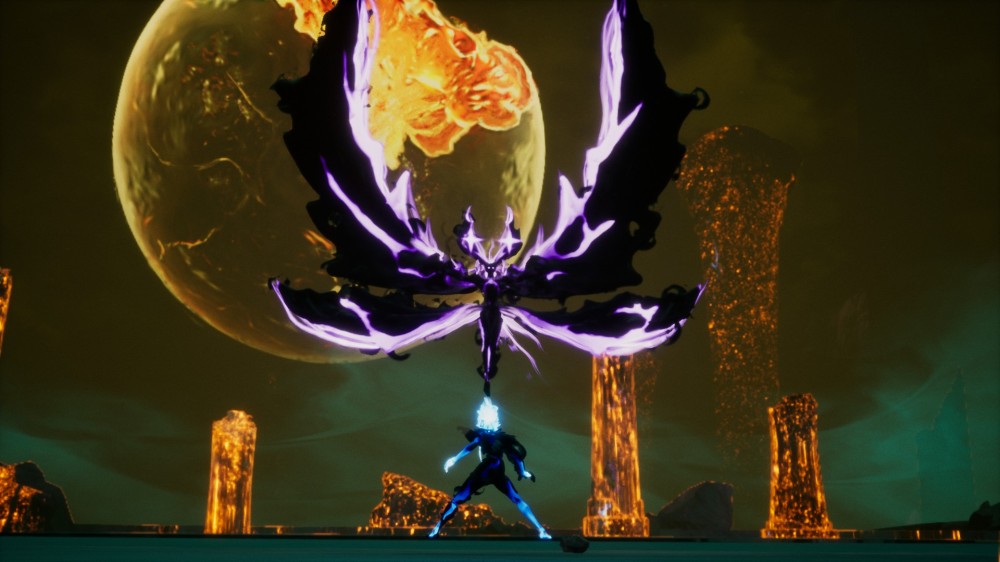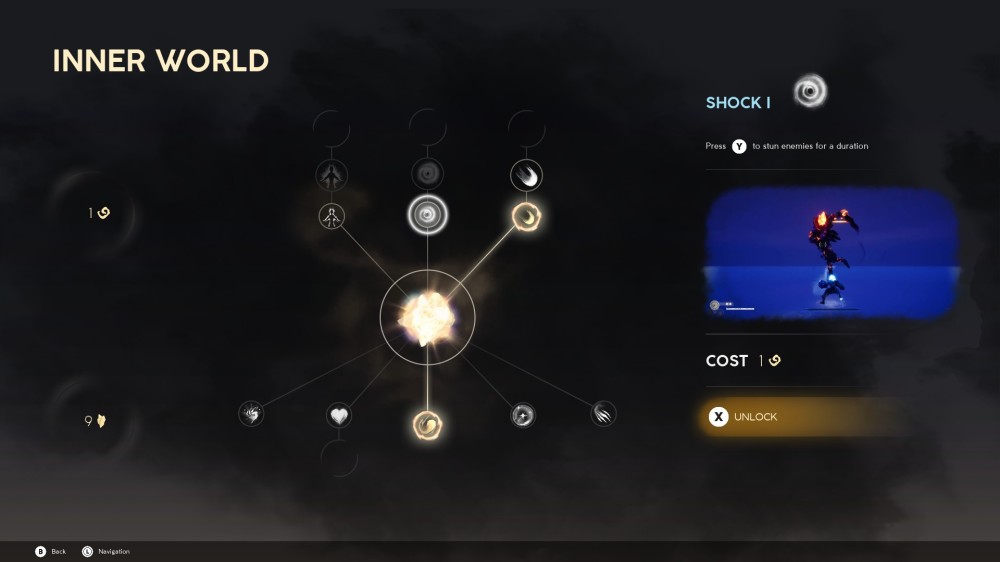Strayed Lights is the debut title from Embers and they’ve certainly come out swinging. It’s a beautiful adventure that has a unique take on combat, pushing you to defend rather than attack. Not everything works, but there’s plenty that does, so let’s review Strayed Lights, shall we?
The story is tricky to summarise as it has an ethereal and deliberately vague vibe that’s only obfuscated further by the fact that there is no dialogue. Basically, you play as a strange, glowing baby that is “born” from a strange pod in what may or may not be the post-apocalyptic ruins of a fallen civilization. As you stumble away from your origins, you encounter your own reflection and upon touching it you grow from a baby to something akin to a child, but you also seem to be split in half, with the darker reflection somehow siphoning some of your light and using it to power itself up. In the ensuing chase, the reflection destroys the light it stole, scattering it across the land. Your job is to find these lost pieces of yourself by journeying through the strange world and confronting your inner demons.
Platforms: Xbox, PC, Swtitch, Playstation
Reviewed On: PC
Developed By: Embers
Published By: Embers
Release Date: 25/04/2023
Review code provided by Embers
There’s plenty of room for mulling over the thematic meaning of Strayed Lights, and quite a few different viewpoints could be spun from its silent protagonist’s little journey through the absolutely beautiful, dreamlike landscapes. Personally, I took it as an allegory for growing up, a process where you have to find all the bits and pieces that make you you and put them all together. But you could also view it as the loss of innocence as you come into adolescence and learning to come to terms with an imperfect world as an imperfect person. You need to tame your anger, feed your curiosity and learn to find beauty in reality rather than in a naïve view of the world.
Of course, if you prefer your stories to be less ambiguous and more direct then Strayed Lights may not be for you. A few collectables you can hoover up in the game’s two hub levels provide slightly more tangible glimpses at what the wider story of the world is, but you’ll never come close to knowing exactly what happened.
It’s impressive just how much empathy and charm the developers manage to put into your avatar’s face, especially since there isn’t much in terms of facial animations. The big, glowing eyes are filled with emotion, and there are feelings imbued into the way characters shrink away in fear or examine something with childlike wonder. It helps that the soundtrack is so strong, too, matching the game’s wonderful use of colour with haunting, lonely, and exciting music composed by industry vet Austin Wintory. Honestly, this is one of the few games where I’d consider buying the soundtrack.
Strayed Lights has a fascinating twist on combat, putting most of the emphasis on blocking rather than attacking in order to build up energy which you release in a blast, instantly wiping out standard enemies. There’s a complication, though: most attacks come in either orange or blue, and if you can match the colour by switching back and forth then you’ll also regenerate some health and extra energy when you parry. Don’t worry, though, because if you don’t match the colour of the incoming attack then you’ll still block the damage.

It’s often said that action games like Devil May Cry 5, or a more literal case in Hi-Fi Rush, are secretly rhythm games in disguise. Weirdly, though, it was Strayed Lights where I felt it the most. Fights play out like this: block, block, swap colours, block, dodge, block, swap, block, swap, block, swap, block. It starts to feel like you’re tapping out the drum track for a song. Some attacks are singular, others have a couple in succession and the big bosses can have lengthy sequences jam-packed with tricky timing where the monster holds back for a second or two longer than you expect or a cheeky feint results in getting smacked across the landscape like a tennis ball.
You aren’t completely without any means to go on the offensive, mind you. There is actually an attack button so that you can nip in for a few sneaky hits, plus three abilities that unleash a more powerful strike, stun foes and briefly allow you to parry any colour of attack without having to swap. These are regulated so that you can’t spam them, though, keeping the focus on patiently defending before going in for a quick strike or two. I suppose you could argue that there’s a Souls-like element to the combat then, but I think the link is tenuous.

Without a doubt, the boss fights are where the game is at its very best because they also tie in thematically. There are handful of them in the game, and aside from being visually striking they put your skills to the test with long attack sequences and tricky timing. It can almost feel unfair as you fall foul of a chain of attacks where the windows to block are never quite where you think they should be, but then it can feel elating when you perfectly defend against an onslaught, regaining every ounce of lost health in the process. You aren’t fighting to win in these battles, rather you defend long enough to charge up a burst of energy which usually initiates a second stage, whereupon you do it again. That second burst will tire most bosses out, finally giving our voiceless hero the opportunity to connect with them, somehow radiating empathy and caring through his glowing eyes.
It ain’t all boss battles, though, because you also face off against a very small variety of regular foes that pepper the oddly sparse environments. There are heaps of big, open areas filled with minimal opportunities to explore and the occasional awkwardness. I think some people are going to find it a bit dull, whereas others will find it enhances the overall tone. After a lot of thought, I think I fall in the first category, finding the areas hollow. They’re just big expanses of space to jog through with the occasional enemy teleporting in before another jog toward the next boss fight. It does give the world a sense of scale, but perhaps a few more light platforming sections could have helped break it all up – although they would need to tighten up the floaty jumping and climbing animations.

Back to the regular enemies, though. There are only a few types and each has a couple of attack patterns, so fights with them quickly begin to feel…samey. The lack of variety really hurts the game here, and that’s despite a playthrough only taking around 2-3 hours. Yes, it’s a very short game and there isn’t too much reason to go back for a second go unless you want to chase trophies and achievements. A few more enemy types would have really helped the combat grow a little, instead of remaining the same for the entirety of the story.
Fending off two attackers also highlights that the combat system is at its best in one-on-one situations. When you’ve got two big bad shadow monsters swinging at your skull it becomes very hard to swap between colours and time your parries, especially when your foe’s attacks pass through each other. You can attempt to back off and use the dodge button to isolate one, but quite a few of their attacks cover large distances. Compared to the solo battles, these team-ups feel messy and less enjoyable.
Along the way, there’s a very lightweight upgrade tree for you to explore. Each enemy drops a small orb of light, encouraging you to engage enemies you could otherwise trundle past, and more can be found scattered around the environments, usually squirreled away in very obvious spots. By visiting your inner mindscape you can spend these on increasing base health, a more damaging counterattack that can be used if you successfully parry every attack in a chain and a few more. The bigger upgrades come when you defeat the bosses, enabling you to unlock and invest in the combat abilities I mentioned earlier.

It’s a barebones system that doesn’t add much to the gameplay because none of the abilities or upgrades are particularly interesting. And I can’t help but feel a little disheartened by the fact that during the quick-time events at the end of boss fights you are shown using awesome new powers such as growing an extra set of arms, and yet never get to use these when you are in control. C’mon, guys, don’t tease me like that!
In the end, I confess to being torn about Strayed Lights. There’s a lot to like about it, from its lovely visuals and wonderful music, to its focus on defence rather than offence. It’s very clearly a project born of love and passion, and a strong debut from a studio who have a great future ahead of them. And yet, even though the game is short, the combat outside of the boss battles is repetitive, the environments are often just a lot of space with nothing in them and the upgrade system is rather pointless. When the credits rolled, I admit to feeling like…wait, that’s it? I was left wanting a little more from the experience.
Strayed Lights is a gorgeous journey through a dreamlike world, one that is often haunting in its size and sense of loneliness. It’s a fantastic debut, a promising start for a new studio looking to make their mark in the incredibly competitive indie-game market. A few missteps hold Strayed Lights back and stop me from recommending it to everyone as a must-play, but for the right group of people this is an excellent experience.





